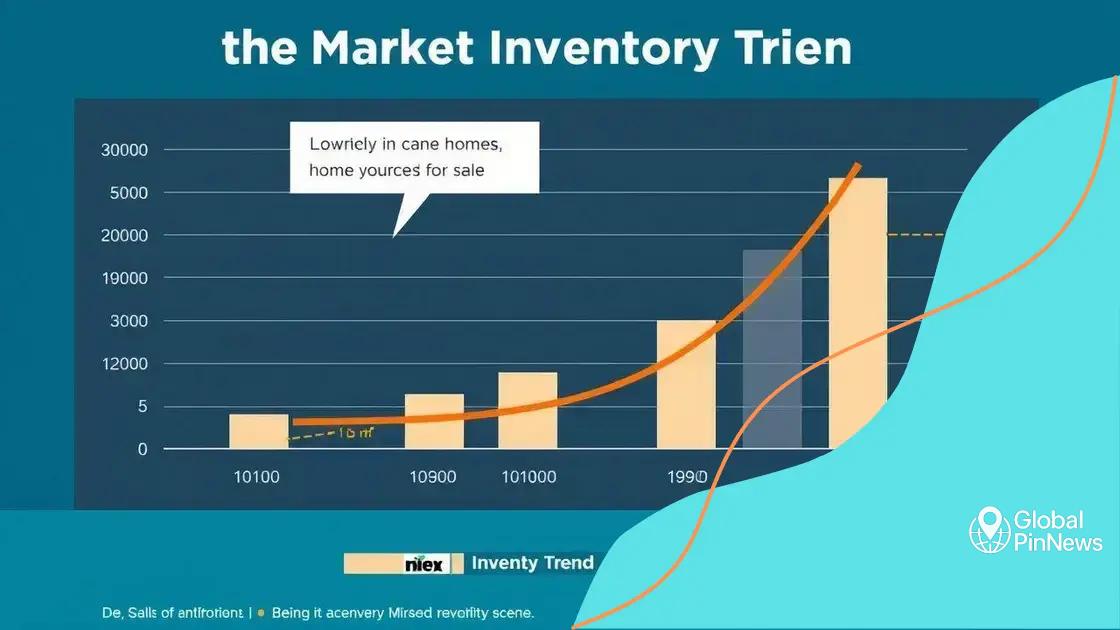Housing market cooling indicators you should watch

Housing market cooling indicators encompass factors like high inventory levels, rising interest rates, and changing buyer sentiment, all of which significantly influence home sales and pricing trends.
Housing market cooling indicators are vital for anyone looking to navigate real estate wisely. But what exactly should you be watching for? In this article, we’ll dive into the key signs that suggest a cooling market.
Signs of a cooling housing market
Recognizing the signs of a cooling housing market is crucial for buyers and sellers alike. This knowledge helps everyone make informed decisions. But what should you look for?
Dropped Home Prices
When you observe that homes are sitting on the market longer and prices are starting to decline, it’s a definitive signal. Homeowners might be forced to lower their prices to attract buyers. This trend often indicates that demand is slipping.
Increased Inventory
Another key indicator is an uptick in the number of homes for sale. If you see more listings in your area, it could mean that sellers are uncertain about the market, leading them to list their homes hoping to sell before prices drop further. High inventory levels can lead to increased competition among sellers, resulting in better deals for buyers.
- Rising number of homes for sale.
- Longer time on the market for listed properties.
- Price reductions becoming more common.
Also, notice the interest rates. When they rise, borrowing becomes more expensive, which can deter buyers. Consequently, fewer buyers in the market can lead to a cooling trend. Influential economic factors, such as job growth and consumer confidence, also play parts in the housing market dynamics.
Slowing Sales Activity
If you’re seeing that homes aren’t selling as quickly as they used to, it’s another red flag. Buyers seek out properties that meet their needs, but when demand decreases, the sales rate also plummets. This can lead to further price drops as sellers become anxious.
Changing Buyer Sentiment
Pay attention to buyer sentiment as well. If potential buyers are feeling uncertain about their financial future, they may hold off on purchasing a home. This hesitation creates a ripple effect, influencing the entire market. Surveys and reports can provide insights into consumer sentiment and expectations.
Incorporating these indicators into your market analysis will greatly aid in understanding when the housing market might be cooling. By staying informed and observing these signs, you position yourself better to make strategic real estate decisions.
Impact of interest rates on home sales
The impact of interest rates on home sales is significant, influencing buyers’ decisions and the overall housing market. When rates rise, many potential buyers find it challenging to afford a mortgage, which can slow down sales.
Understanding Interest Rates
Interest rates are the cost of borrowing money to buy a home. When these rates are low, buyers can save money on monthly payments, making homeownership more accessible. On the other hand, high interest rates increase the cost of loans, discouraging some buyers from entering the market.
Declining Sales Activity
As interest rates climb, the number of home sales often declines. Fewer buyers in the market lead to a slowdown in overall sales activity. Many potential homeowners may hold off purchases, waiting for rates to decrease again. This reduced demand can put pressure on sellers to lower their prices, further affecting the market.
- Higher monthly mortgage payments can deter buyers.
- Buyers may place offers below asking prices.
- Home inventory might increase due to fewer sales.
Additionally, rising interest rates can contribute to a shifting market dynamic. When rates start to rise significantly, it can lead to a more competitive environment for remaining buyers. On the flip side, sellers may be more flexible with pricing during these times.
The Ripple Effect
Moreover, a prolonged rise in interest rates can have a ripple effect throughout the economy. While it’s evident that the housing market feels the pinch, various other sectors often experience changes as well. Contracts and negotiations can be prolonged as buyers reassess their financial capabilities.
Staying informed about the current interest rates can empower buyers and sellers to make better decisions. Understanding how these rates affect their situation is key to navigating the housing market successfully.
How inventory levels indicate changes

How inventory levels indicate changes in the housing market is crucial for understanding the dynamics of buying and selling homes. When inventory levels fluctuate, they can reveal significant trends affecting pricing and buyer behavior.
High Inventory Levels
When inventory levels are high, it typically means that many homes are for sale. This situation often leads to increased competition among sellers. In such cases, sellers may start to lower their prices to attract buyers, which can lead to a cooling market. Homebuyers have more options and can negotiate better deals when there are plenty of homes available.
Low Inventory Levels
Conversely, low inventory levels often indicate a tighter market. Fewer homes for sale can drive prices up, as buyers compete for limited options. When inventory is low, it can create a sense of urgency among buyers, leading to multiple offers on properties. This demand can cause bidding wars, resulting in homes selling above their asking prices.
- High inventory leads to more negotiating power for buyers.
- Low inventory results in faster sales and possible bidding wars.
- Changes in inventory can shift market trends quickly.
Monitoring inventory levels offers valuable insights into market health. If more homes are coming onto the market, it could signal that sellers are anticipating a downturn or that prices are too high. On the other hand, extended low inventory might indicate a strong demand, reinforcing price stability or increases.
Market Strategies Based on Inventory
Understanding inventory trends can help potential buyers and sellers strategize effectively. For buyers, high inventory levels might be the right time to make a purchase. For sellers, understanding whether their home is one of many can help in setting the right price.
By keeping an eye on inventory levels, both buyers and sellers can position themselves better in the housing market, ensuring they make informed decisions.
The role of economic factors in real estate
The role of economic factors in real estate is critical, as these factors can significantly affect home values and market activity. Understanding these elements can help buyers, sellers, and investors make informed decisions.
Interest Rates
One major economic factor is the interest rate. When rates are low, borrowing money for a mortgage becomes cheaper, which encourages more people to buy homes. This increased demand can drive up home prices. In contrast, when interest rates rise, fewer people may qualify for loans, leading to a slowdown in home sales.
Economic Growth
Another important consideration is economic growth. When the economy is thriving, more jobs are created, and consumer confidence rises. This positive outlook means that more people are willing to invest in real estate. However, if there is an economic downturn, job losses can lead to reduced buyer demand.
- Higher employment rates typically result in higher home sales.
- Wages rising can allow more buyers to enter the market.
- A strong economy often correlates with faster price increases.
Additionally, inflation impacts real estate. As the cost of living rises, property values can also increase. However, if inflation rates are too high, it may scare away potential buyers who feel uncertain about their financial stability. Land use, zoning laws, and local economic conditions play significant roles in real estate trends as well.
The Housing Market and Supply Chain
The state of the supply chain can affect material costs for new construction. If construction materials are expensive or in short supply, this can delay projects and increase home prices. Local policies and regulations can also influence the housing market, determining how quickly new homes can be built or renovated.
In summary, keeping an eye on economic trends and indicators can provide valuable insights into real estate. Having this knowledge helps stakeholders maneuver through changing market conditions effectively, whether they are buying, selling, or investing.
Homebuyer sentiment and market trends
Homebuyer sentiment and market trends are closely intertwined and can significantly influence the housing market. Understanding how buyers feel about the market can help predict future trends in real estate.
Current Sentiment
Homebuyer sentiment reflects how confident buyers are in the market. When sentiment is positive, buyers are more likely to make purchases. Factors like job security, income stability, and interest rates often play crucial roles. Currently, many buyers are cautious due to fluctuating rates and economic uncertainty, which can slow down sales.
Impact of Buyer Sentiment on Market Trends
Negative sentiment can lead to decreased demand in the housing market. If buyers feel uncertain about their financial future, they may wait before making a purchase. This hesitation can cause inventory levels to rise as homes sit unsold. When fewer homes are purchased, sellers may lower prices to attract buyers, affecting overall market health.
- Positive sentiment encourages buyers to purchase homes.
- Negative sentiment can lead to increased inventory and lower prices.
- Consumer surveys often measure sentiment to predict trends.
Moreover, tracking buyer sentiment helps real estate professionals gauge the market. Surveys and reports showing consumer confidence can provide insights into potential drops or spikes in activity. As sentiment shifts, so do market trends. Understanding these shifts allows buyers and sellers to make informed decisions.
Economic Indicators
Various economic indicators, like job growth and inflation, also impact buyer sentiment. A strong job market usually boosts confidence, making buyers feel more secure in their ability to invest in real estate. However, high inflation may cause concern, leading to cautious behavior in the market.
In summary, monitoring homebuyer sentiment is essential for understanding market trends. Recognizing how buyers feel about their prospects can reveal much about future activity in the housing market.
FAQ – Questions About the Housing Market and Buyer Sentiment
How do interest rates affect homebuyer decisions?
When interest rates are low, borrowing is cheaper, encouraging more buyers. Conversely, high rates can discourage purchases as monthly payments increase.
What is the impact of buyer sentiment on the housing market?
Positive buyer sentiment often leads to increased home sales, while negative sentiment can result in fewer transactions and higher inventory.
How can I stay informed about market trends?
Regularly check real estate reports, consumer confidence surveys, and economic news to understand shifting market dynamics.
What economic factors should I consider when buying a home?
Key factors include interest rates, job growth, inflation, and overall economic conditions that can influence your purchasing power and market trends.
